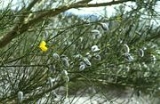
Cytisus striatus
Encyclopedia
Cytisus striatus is a species of flowering plant in the legume family
known by the common name Portuguese broom. This plant is native to the Iberian Peninsula
.
This shrub is similar to its relative, Cytisus scoparius
, but it can be distinguished by the paler shade of yellow of its flowers and by the hairy coat on its pods.
. It was introduced to California
in the 1960s as an erosion-controlling plant, but it 'escaped' and spread to become a major noxious weed, an invasive species
colonizing
in many habitat
s there. It is also caused ecological damages in Oregon
.
This plant, beyond its native range, causes problems in many ways, including displacement of native species causing ecosystem
degradation and loss, removing native plant
food sources for wildlife, and a susceptibility to wildfire ignition and spread.
Fabaceae
The Fabaceae or Leguminosae, commonly known as the legume, pea, or bean family, is a large and economically important family of flowering plants. The group is the third largest land plant family, behind only the Orchidaceae and Asteraceae, with 730 genera and over 19,400 species...
known by the common name Portuguese broom. This plant is native to the Iberian Peninsula
Iberian Peninsula
The Iberian Peninsula , sometimes called Iberia, is located in the extreme southwest of Europe and includes the modern-day sovereign states of Spain, Portugal and Andorra, as well as the British Overseas Territory of Gibraltar...
.
Description
This is a tall shrub often exceeding two meters-six feet in height. It is highly branched and sprawling. The sparse leaves are made up of small leaflets about a centimeter long each. The shrub bears yellow legume flowers and the pods are covered in white hairs.This shrub is similar to its relative, Cytisus scoparius
Cytisus scoparius
Cytisus scoparius, the Common Broom and Scotch Broom, syn. Sarothamnus scoparius, is a perennial leguminous shrub native to western and central Europe,....
, but it can be distinguished by the paler shade of yellow of its flowers and by the hairy coat on its pods.
Invasive plant species
It is also known in other parts of the world as an introduced speciesIntroduced species
An introduced species — or neozoon, alien, exotic, non-indigenous, or non-native species, or simply an introduction, is a species living outside its indigenous or native distributional range, and has arrived in an ecosystem or plant community by human activity, either deliberate or accidental...
. It was introduced to California
California
California is a state located on the West Coast of the United States. It is by far the most populous U.S. state, and the third-largest by land area...
in the 1960s as an erosion-controlling plant, but it 'escaped' and spread to become a major noxious weed, an invasive species
Invasive species
"Invasive species", or invasive exotics, is a nomenclature term and categorization phrase used for flora and fauna, and for specific restoration-preservation processes in native habitats, with several definitions....
colonizing
Colonisation (biology)
Colonisation is the process in biology by which a species spreads into new areas, regions, and continents. It is sometimes also referred to as immigration, but colonisation often refers to successful immigration with integration to a community, having resisted initial local extinction.One classic...
in many habitat
Habitat
* Habitat , a place where a species lives and grows*Human habitat, a place where humans live, work or play** Space habitat, a space station intended as a permanent settlement...
s there. It is also caused ecological damages in Oregon
Oregon
Oregon is a state in the Pacific Northwest region of the United States. It is located on the Pacific coast, with Washington to the north, California to the south, Nevada on the southeast and Idaho to the east. The Columbia and Snake rivers delineate much of Oregon's northern and eastern...
.
This plant, beyond its native range, causes problems in many ways, including displacement of native species causing ecosystem
Ecosystem
An ecosystem is a biological environment consisting of all the organisms living in a particular area, as well as all the nonliving , physical components of the environment with which the organisms interact, such as air, soil, water and sunlight....
degradation and loss, removing native plant
Native plant
Native plant is a term to describe plants endemic or naturalized to a given area in geologic time.This includes plants that have developed, occur naturally, or existed for many years in an area...
food sources for wildlife, and a susceptibility to wildfire ignition and spread.

